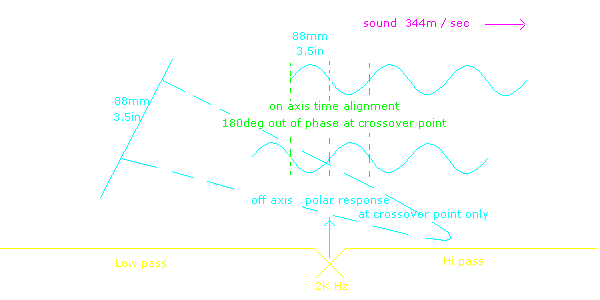Many years ago the term 'Time alignment' referred to speaker placement in large auditoriums, churches, stadiums, race courses, etc. Sound travels at approx 344 meters / sec. The large distance between speakers could cause excessive echoes. Signal to distant speakers is electronicly delayed at the equivalent of 344 meters / sec. In recent years modern marketing trends have made 'time alignment' also refer to the very small distances, between voice coil alignments of woofer and tweeter.
At the point where the woofer crosses over to the tweeter, both cones should be moving in phase. When mounted in a box, the woofer and tweeter voice coils are slightly out of vertical alignment. Technical management of time alignment has always been known. Recent marketing trends have made 'time-alignment' into an obsession. Time alignment can also be looked at when listening to a musical group or an orchestra. The musicians being in different places, left, right, forward or back.

In the examples given, sound from the woofer arrives late by less than half a milli-second (1/2 a thousandth of a second) relative to the tweeter. This causes a lobe or small shift in polar response, on axis at the crossover point only. Time alignment shifts effect detail points in the frequency and polar response but do not effect overall sound energy and enjoyment of music. Some audiophile systems have speakers at the sides, rear or facing upward, spreading sound around the room. Facing speakers in different directions increases time-alignment shifts, lobeing and comb filter distortion, decreasing intelligibility while making contradictory marketing statements about 'time-alignment' correction.

Small shifts caused by vertical crossover alignments are difficult to hear and measure. A trained ear can hear subtle differences of alignment shifts, during real time switching comparison only but not when stationary. That is, the ear is unable to pick which speaker is in alignment, forward or back, in a double blind test. Correction for time alignment is purely academic and it can be done. There are those who can not sleep unless this correction is implemented.

One solution is to simply move the speakers so the voice coils are physically aligned. The other is to use complex high order passive crossovers designed with time alignment correction. This introduces other losses which are often more detrimental. Most domestic and professional passive speaker systems rarely use this correction. Active crossovers can have time alignment correction that does not contribute losses in other areas.
Exaggerated Time Alignment Experiments
Time Alignment experiments can be exaggerated with 2 microphones at full range, one physically forward of the other. With exaggerated continual large movement of one mic (3ft/1m) a choral flanging effect is heard but not when stationary. The experiment repeated with the 2 mics crossed over, high pass and low pass, (similar to a speaker crossover). With small static movements similar to the distances of woofer and tweeter alignments the ear cannot pick which mic is in alignment, forward or back. Meaning, the ear cannot hear small static shifts in phase.

The experiments can be repeated with 2 speakers at full range, one physically forward of the other. With exaggerated continual large movement of one speaker (3ft/1m) a choral flanging effect is heard but not when stationary. Again, time alignment can also be questioned when listening to a musical group, or an orchestra. The instruments are in different places, left and right, forward and back.
Marketing Fads
There are fads in marketing inferring that the words 'time-aligned' alone, magically transform the whole sound quality, believing this is more important than using quality speakers. The term 'time-aligned' can be used at random stamped on products similar to washing machines stamped with 'heavy duty'. There are audiophiles who have obsessions with 'time alignment' that go beyond having a sense of perspective. These obsessions are equivalent to painting a single grain of sand a different colour, throwing it back in the beach and expecting to find it when one is allready unable to find ones keys.
Harmonic Sidebands
In the visual world we can photograph (freeze) an image and it remains intact. If we freeze music it appears as filtered noise. The unfolding of this is extensive. This is a simple explanation

Music is a multitude of notes shifting in frequency, amplitude and phase. These notes create interference patterns with each other (auditory equivalent of a rainbow). In nature these patterns are of infinite complexity and form moving mirrored structures on both sides of the musical notes that created them (upper and lower harmonic side-bands). Music is the richness, detail and beauty of these side-bands. If we freeze music at any one note the harmonic side-bands disappear.

Music through a speaker system deviates from the original by the harmonic side-bands becoming shifted and unbalanced. Accumulation of all limitations in system design (previously mentioned throughout this text) results in the unbalancing of harmonic side-bands.
Listen to music while switching between different speaker systems (all having a flat response) and notice how different they sound particularly in tonal colour. Frequency response measurement alone is of insufficient complexity to reveal a speaker systems capacity to accurately reproduce the harmonic side-bands and sound natural. Realism is best achieved through 4-way active technology.


